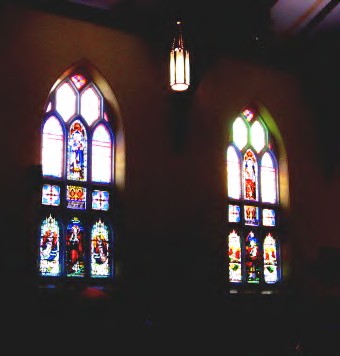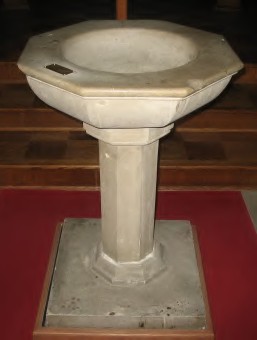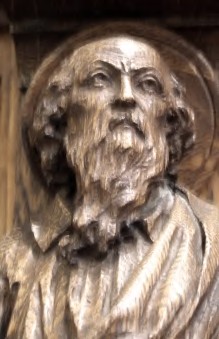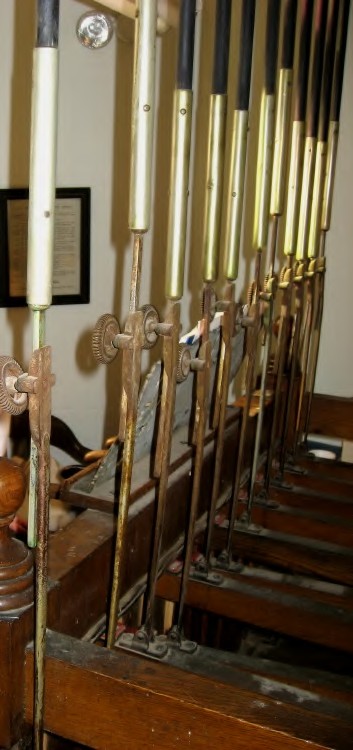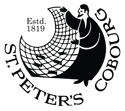About This Publication
Nearly all of the following material is taken from the book: “Cobourg’s Churches over the Life of the Town” which was published as a fund-raiser in 2012 by Neighbour- Link Northumberland* on the occasion of Cobourg’s 175th anniversary, Both that book, which covers 15 Cobourg area churches, and this publication were written and produced by Jim Weller, a member of St. Peter’s.
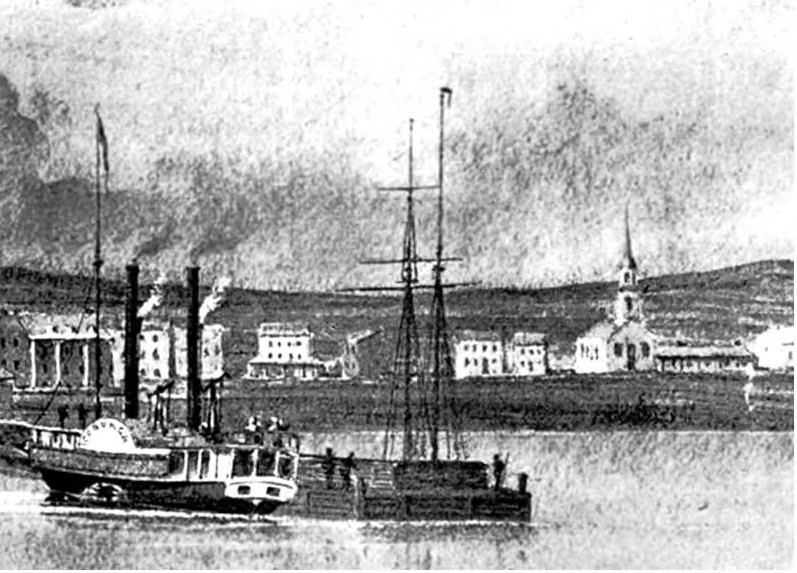
A brief history of St. Peter’s
By Jim Weller
Members of The Church of England were active in what later became Cobourg almost since set- tlement began in the late 1700s when, following the American Revolution, immigrants began to settle here. Up to 1818, however, there were still fewer than 100 people in the village variously known as Amherst and/ or Hardscrabble (the farmer’s version), Buckville, and Hamilton.
Religious activities had started early in the century when the Church of England’s Society for the Propa- gation of the Gospel (SPG) began to sponsor travelling missionaries. These hardy souls held worship services, offered communion, baptisms, marriages and burials and generally brought religion to the hard lives of set- tlers. They served Church of England members as well as other Christian affiliates.
Macauley appears to have been the person who sug- gested the name ‘Cobourg’ according to his obituary in 1874. The name was chosen to honour the marriage of Princess Charlotte (daughter of George IV) to Prince Leopold of Saxe Coburg in 1819. Historians believe the extra “o” in Cobourg came through a spelling mis- take by a clerk.
The year 1818 was a turning point as the Bishop of Quebec, Jacob Mountain, whose jurisdiction then en- compassed both Lower and Upper Canada, felt the growing community here needed a permanent church. He appointed the newly-ordained Rev. William Macauley, to establish a church in what was to become Cobourg. Born in Kingston in 1794, Macauley was the son of United Empire Loyalists. He had been edu- cated by the Rev. John (later Bishop) Strachan, and at Oxford University. Macauley’s first services were held in a wooden building that served both as courthouse and jail on land that had been donated by the Burnham family. It is now the site of the Golden Plough Lodge.
The name Cobourg
Macauley appears to have been the person who sug- gested the name ‘Cobourg’ according to his obituary in 1874. The name was chosen to honour the marriage of Princess Charlotte (daughter of George IV) to Prince Leopold of Saxe Coburg in 1819. Historians believe the extra “o” in Cobourg came through a spelling mis- take by a clerk.
Macauley had his work cut out for him. Besides the need for pastoral care in Cobourg, he was required to regularly visit Carrying Place, Belleville, Presqu’ile, Haldimand and several other places to the east, but he was determined to see a proper church building in Co- bourg. Land for such a church was donated by John Spenser, an early settler, who deeded four acres—half to be set aside for a rectory.

The Rev. Alexander Bethune was rector of St. Peter’s for 40 years. A keen educator, he was also a member of the executive council of Upper Canada. He subsequently became the second bishop of Toronto.
A Little Wooden Church
By 1820, a white clapboard wooden church 56’ by 44’ stood on the present site of St. Peter’s. It apparently had a weather vane in the shape of a fish that caused the village to be dubbed ‘Salmon City’ by some people according to historian Percy Climo. The first service took place on Christmas day of that year. Four years later, a modest rectory was built nearby.
Cobourg continued to grow, as did the congregation. In 1827 Macauley left St. Peter’s for the newly-formed parish of St. Mary Magdalene, Picton where, accord- ing to that church’s website, he is also credited with having suggested the name of that town! In 1829, Macauley was succeeded at St. Peter’s by the Rev. Alexander Bethune, another former student of Bishop Strachan.
Bethune was a prominent member of the Family Com- pact whereby conservative landowners controlled com- merce, finance and education leaving little power to the elected legislators. The Family Compact, of which five members were either from Cobourg, or married into Cobourg families, interpreted the Constitutional Act of 1791 in favour of the Church of England and received exclusive Anglican access to the Clergy Re- serves which held 1/7th of all the Crown Lands in Up- per Canada. The Anglican church also claimed exclu- sive right to perform marriages and funerals and to own land to the exclusion of other Christian denomina- tions. A key player in this was the Rev. John Strachan, Bethune’s mentor, the prominent Anglican priest and educator who had become a member of the Executive Council of Upper Canada and, eventually, the first bishop of Toronto.
During the 1830s, prompted by completion of the har- bour and the arrival of many immigrants from the Brit- ish Isles, Cobourg’s population increased substantially, as did St. Peter’s congregation.
In 1837 Bethune’s work at St. Peter’s included editing a weekly newspaper called ‘The Church.’ with wide circulation throughout Upper Canada. It was founded by Strachan, and Bethune was an accomplished writer. It naturally promoted the church’s position relative to the clergy reserves. Also, part of the reason for its ap- pearance was that the Rev. Egerton Ryerson, a minis- ter in the Episcopal Methodist Church ( and a former Anglican!) who strongly promoted the separation of church and state and Jesse Ketchum, his wealthy political col- league, were becoming thorns in the side of Bishop Strachan, appar- ently making the bishop’s life miserable.
As the population of Upper Canada increased in the late 1830s, the diocese of Quebec be- came too large for one bishop to handle. In 1839, the new diocese of Toronto was formed, and this area fell under its jurisdiction with John Strachan as its bishop.
In 1852 St. Peter’s engaged its first curate, the Rev. William Johnson, to help with the increasing work load on the rector. The church also provided his ac- commodation.
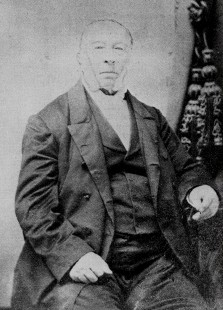
Rev. William Macauley, St. Peter’s first rector (1818-27) apparently suggested the name Cobourg. He was also appointed Chaplain of the Legislative Council of Upper Canada.
A new, larger church
In 1844 the church was enlarged and a tower and spire added. But this was only a temporary measure for it soon became clear that a much larger church was needed to accommodate the rapid growth at that time and the kind of growth anticipated in the future. Co- bourg, at that time, held aspirations to become a major centre of Upper Canada and probably would have done so but for the collapse of the Cobourg-Peterborough railway bridge over Rice Lake in 1861.
Kivas Tully, a well-known architect who later de- signed Cobourg’s Victoria Hall, was engaged as archi- tect for a Gothic-style brick rectangular building meas- uring 134’ x 52.’ in a light coloured brick. It was de- signed to face north rather than East, as was more usual in the Church of England tradition. The absence of a transept, which would have created a cruciform floor plan, was a contentious issue, but the rectangular design remained. Work began in 1851 and, to mini- mize inconvenience to the congregation, the new church was actually built around the existing one and then the old building was removed.
For a short while services were held in the malt room of a nearby brewery belonging to Mr. James Calcutt. This is thought by some to have been associated with the building that is now Cobourg’s museum. The new church was opened in October 15, 1854.
One question raised in connection with the new build- ing was whether or not the pews should have doors. Eventually it was agreed that those who wanted their pews to have doors added should pay 50% of the cost of materials.
By 1865, the larger church for the living meant less space for burial of the dead and ten acres of property on Ontario St., south of Pratt’s Mill, was purchased from the Burnham family for a new cemetery now known as St. Peter’s Heritage Cemetery. In 1888 a mortuary chapel was added to facilitate winter storage of bodies awaiting burial. This was to a design by well -known architect Frank Darling who also designed the former Bank of Montreal building in Toronto that is now the Hockey Hall of Fame. The chapel originally contained two fine stained glass windows. However, these were relocated in the 1970s to the main church on the stairs leading to the balcony to avoid vandalism Recently, a memorial garden with three columbaria has been added and other improvements made, making it the attractive area it is today. It was renamed St. Pe- ter’s Heritage Cemetery around the year 2,000 and is open to all faiths.
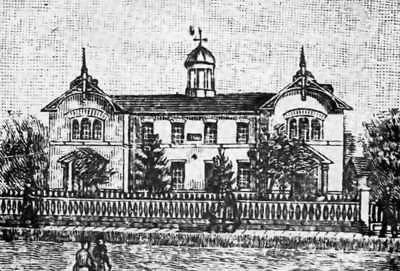
St. Peter’s was involved in the founding of a parochial Grammar School on church-owned (glebe) land opposite the rectory in the 1820s. The building is now apartments at 117 King St. East.
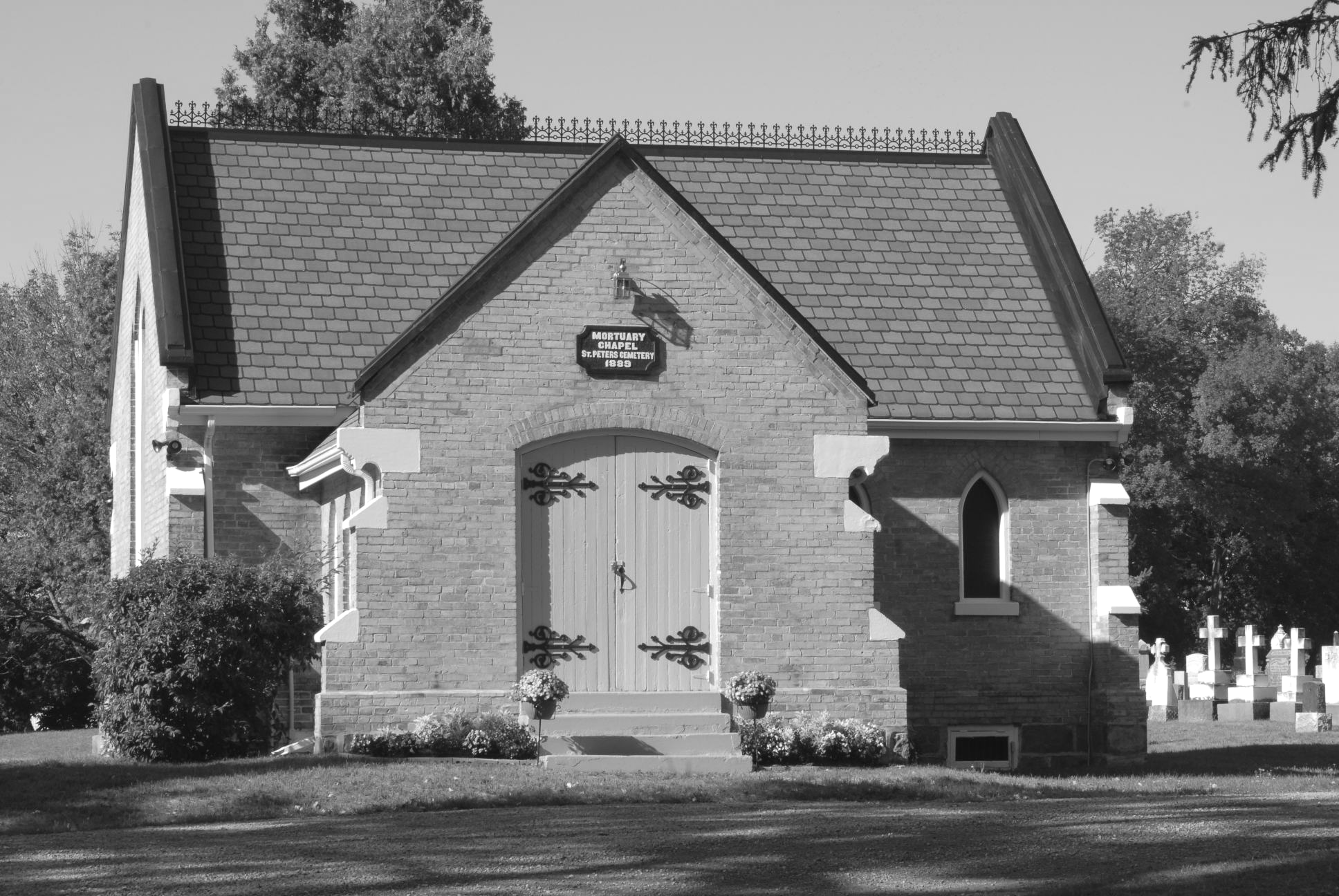
In 1888 St. Peter’s new cemetery added this architecturally significant mortuary chapel for winter storage of bodies.
Independence from the Mother church
Canada’s confederation year inh1867 was also signifi- cant for both St. Peter’s and for the Anglican Church in Canada as a whole. Alexander Bethune, who had been the highly revered rector of St. Peter’s for 40 years, briefly became bishop of Niagara and then Bishop of Toronto where he followed his mentor John Strachan. According to the local newspaper this marked “the final separation of the Church of England in this province from the Church in the Mother coun- try.” This important change occurred because Bethune was consecrated bishop of Toronto without a mandate from the Crown. This was interpreted as recognition by the Church of England of the independence of the colonial Church in Canada.
St. Peter’s has an interesting indirect connection with the silent film era. Its organist and choirmaster for a brief time in the 1870s was Alexander Koerber whose daughter Leila Marie Koerber later became the famous film star, Marie Dressler. Before Marie left home at age 14, to start her acting career, she sang in the church choir and pumped the organ for her father’s practice sessions.
In 1886 a chancel to accommodate the choir, which had previously sung in the balcony, was added to the North end of the church as a memorial to Bishop Be- thune. In 1894 further improvements to the church, prompted by two large bequests, included the first stained glass windows and new pews. These pews were arranged to allow a central aisle instead of two separate aisles. Some of the original, uncomfortable pews and two separate aisles still remain in the gallery.
Bells meant the steeple had to come down
In October 1904, to mark the 50th anniversary of the new church building it was decided to order a chime of ten bells from a New York bell foundry. It was a large undertaking made even larger by the tower being un-able to withstand both the weight of the steeple and the weight of the new bells. This meant the steeple had to be taken down, thereby depriving Cobourg of one of its prominent landmarks. Production of the bells fell behind the planned schedule and they were finally dedicated in May of 1905.
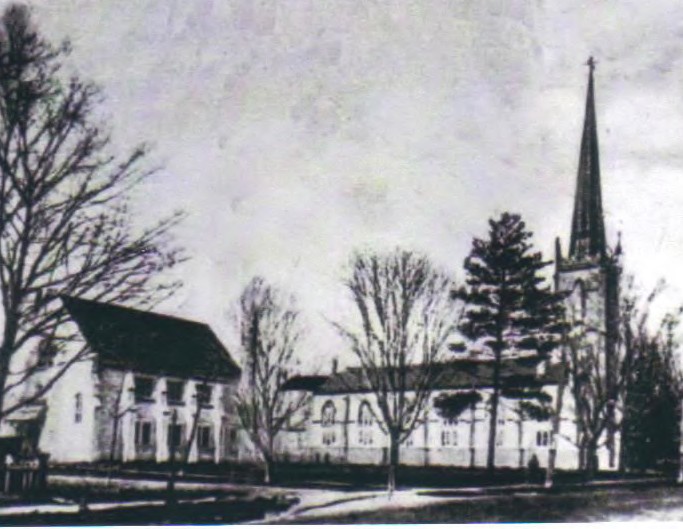
This view from the early 1900s shows the Sunday School building (now Sheppard Hall) and the church spire shortly to be removed to compensate for the weight of new tower bells.
Fourteen paid supreme sacrifice in World War I
World War 1 had a profound effect on the life of St. Peter’s. In August 1914 just three weeks from the outbreak of war St. Peter’s hosted a special service for servicemen about to go overseas from the 40th Northumberland Regiment. In March 1915 the col- ours of the 139th were deposited in due ceremony at St. Peter’s. By 1917 the church’s Honour Roll contained 111 names, of which eight had paid the supreme sacrifice. The final count was 14 men of the parish whose names are commemorated in a Memo- rial tablet on the back wall of the church.
In 1917 St. Peter’s and all other parishes in the Diocese of Toronto at their annual meetings were asked what they thought of changing the name of the de- nomination from the Church of England to a more Canadian one. After one month’s deliberation on the matter St. Peter’s decided the name should re- main The Church of England. This must have been a view of many other parishes since it was not until 1955 that the name was finally changed to The Anglican Church of Canada.
Memorial gifts, including several pieces of much- needed church furniture such as clergy prayer desks and a six-sided oak pulpit, adorned with carved figures of the four gospel writers, were donated around 1917. Also, more of the high- quality stained glass windows in the sanctuary, most of them as memorials to former parishioners, were added around that time.
Two Enduring Mysteries
In 1921 St. Peter’s received the gift of a painting of Madonna and Child from a Mr. Gerald Hayward of New York, who had a summer house at Gore’s Landing. It was accompanied by the statement: “Bought by Francis Hayward in Rome 180 years ago supposed to be painted by Anthony Van Dyke.” The painting was placed in storage and forgotten until 1958 when it received media attention in the Globe and Mail by being sent to Toronto for extensive restoration and to determine whether, in fact, it really had been painted by Van Dyke. The newspaper quoted the restorer, Percy Smith, as saying he had no doubt of its seventeenth century origin, and that ‘it might possibly have come from Van Dyke himself’ but he declined to give a categorical response.
In 1924, when grounds around the church were being leveled, a hole in the ground appeared near the south east corner of the church building. Investigation revealed a vault, 12 ft by 10 ft, constructed to accommodate three bodies. However, only one was found in a lead casket made to conform to the shape of the body. There was a door to the vault from the side of the church and steps in good condition. Since there was also a basement door at the rectory, the find gave rise to a remarkably enduring, but highly speculative, story that there had actually been a tunnel between the church and the rectory to allow the rector to get to the church in all weathers!
In 1927, the Sunday School building and the church were joined together by a one-story structure. The additional space this created was used initially as a meet- ing and games room for the Men’s Club of the parish. In 1957 it was converted into a chapel dedicated to St. Paul. Stained glass windows depicting the life of St. Paul were added plus some church furniture from the former Hatfield Hall girls’ school which had closed.
In August 1928 the responsibility of St. Peter’s was expanded when two other parishes came under its wing. These were St. George’s, Grafton and St. John’s, Centreton. However, in 1930, when the depression started, the arrangement was dismantled because it allowed the rector and curate too little time to address the increasingly pressing needs of St. Peter’s
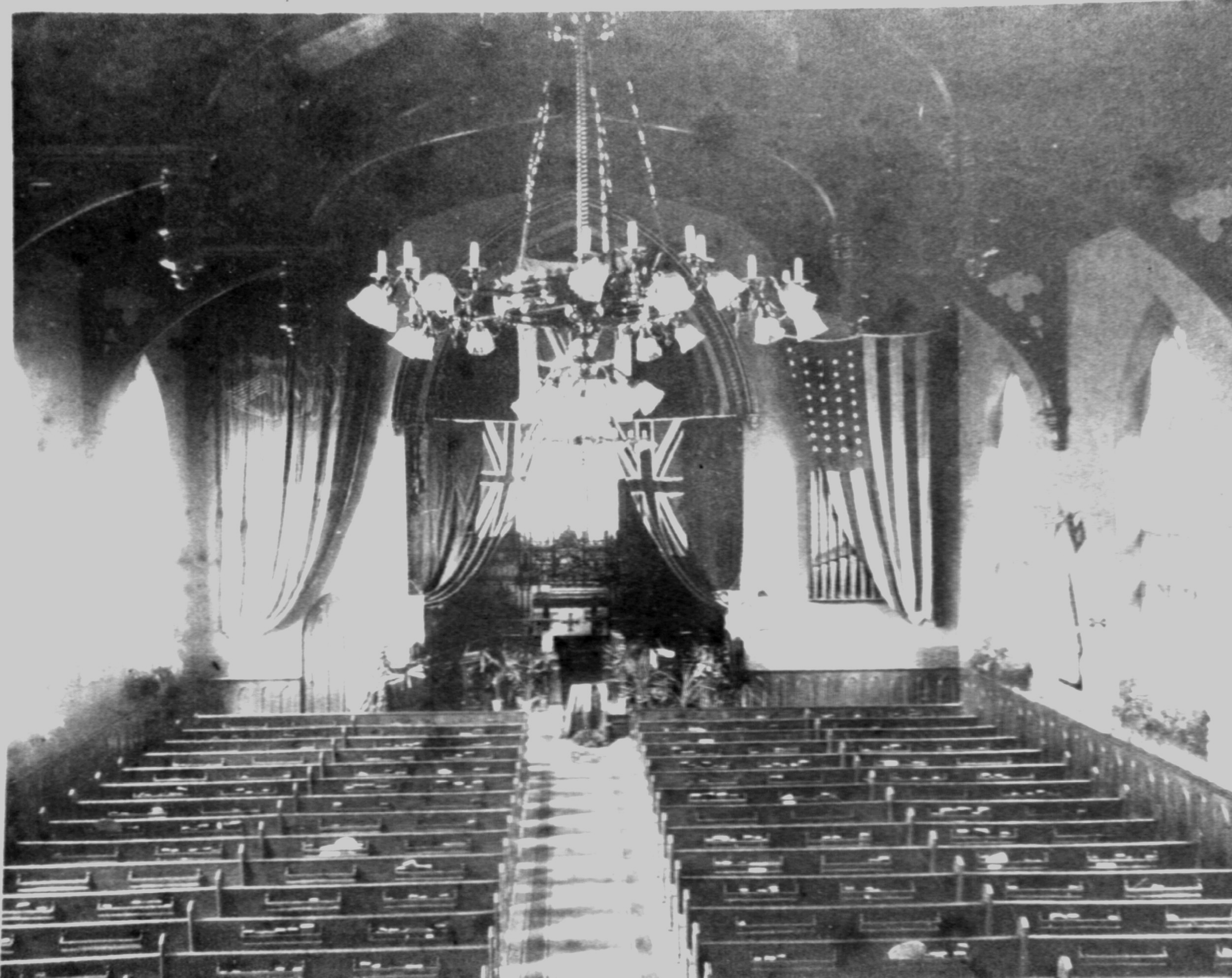
Preparations for an early 1900s wedding of a Cobourg resident and a family member of US visitors who had a summer home in the town.
A Private Christian Girls’ School
In 1929, under the direction of St. Peter’s Rec- tor, the Rev. Dr. Temple Boyle, a private Anglican girl’s school called Hatfield Hall was opened on Green St., in a former summer residence of a wealthy family. It replaced the Bishop Bethune College, a girl’s private school in Oshawa, which had closed.
Temple Boyle became president of Hatfield Hall and it maintained very close ties with St. Peter’s. Accommodation for the school was further extended by a gift from a parishioner of another residence and its surrounding grounds on King St. East. The school had to close in 1952 due to its inability to attract suitable re- placements for its two most senior members of staff.
For many years, parishioners who could afford it, paid for pews in locations where acoustics and sight-lines were good. This provided a useful source of revenue for the church. However, over time, it became a highly contentious issue due to its discriminatory con- notation as well as for the difficulty in collecting fees from an increasing number of wayward pew-holders. It was not until 1936 that the few remaining pews for rent, which at that time yielded a mere $300 per annum, were finally made available to anyone attending services regardless of their income.
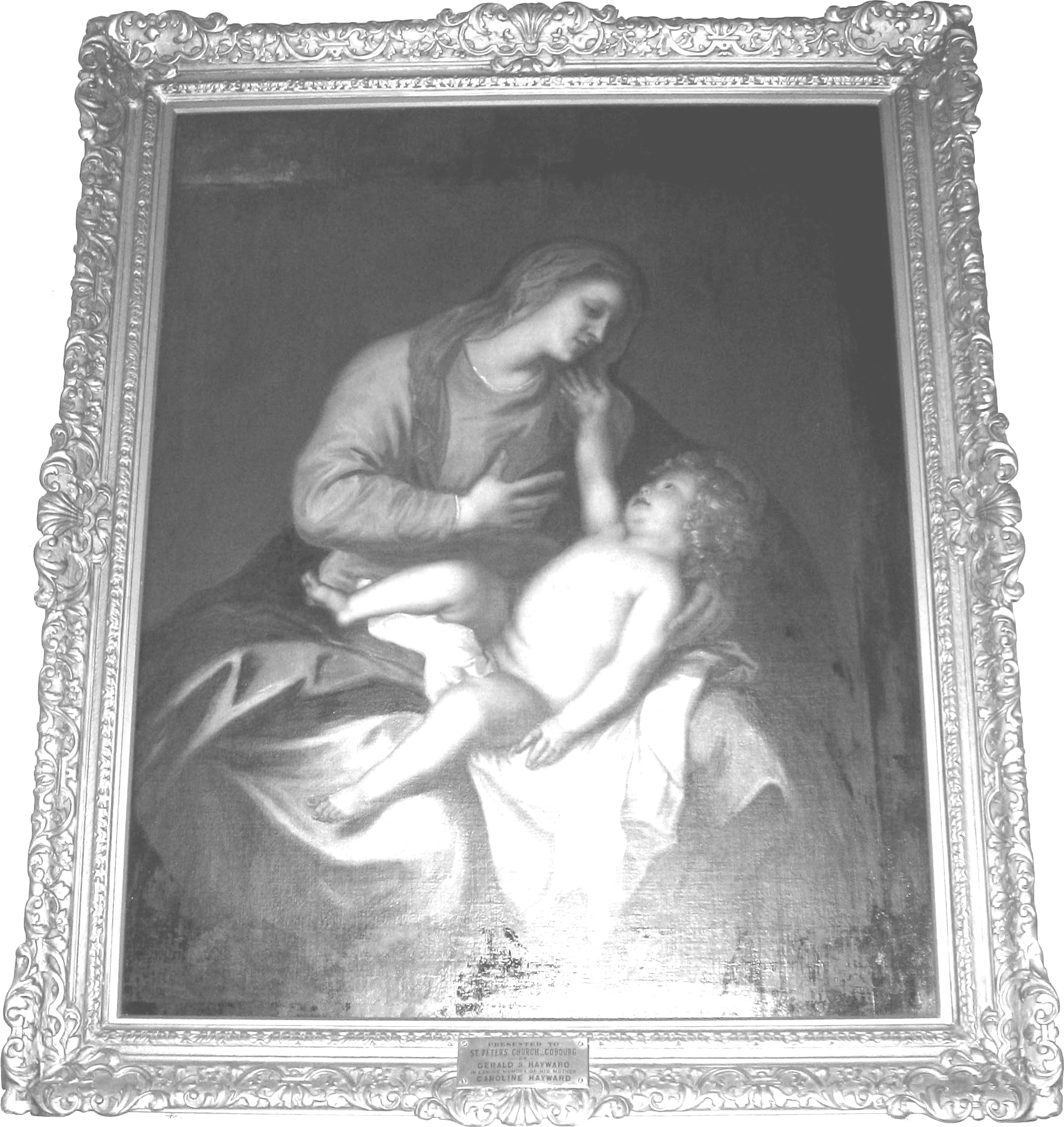
The 17th century donated painting of Madonna and Child, now displayed in the church chancel, has been the subject of speculation as to whether it was actually painted by Van Dyke.
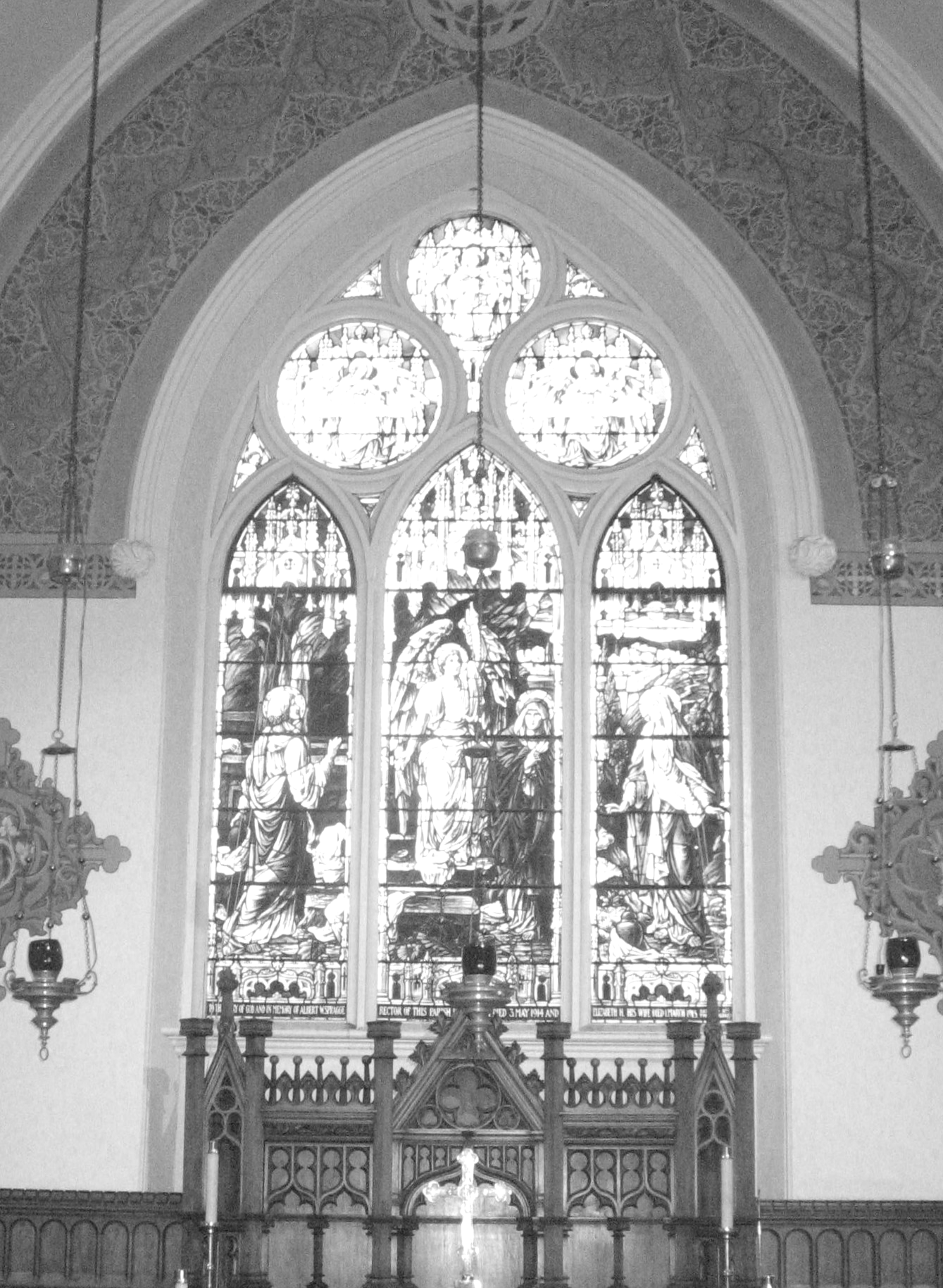
One of many fine stained glass windows is the ‘Easter Window’ above the altar on the north chancel wall presented by the Spragge family in memory of Canon Albert Spragge, rector of St. Peter’s from 1889 to 1915.
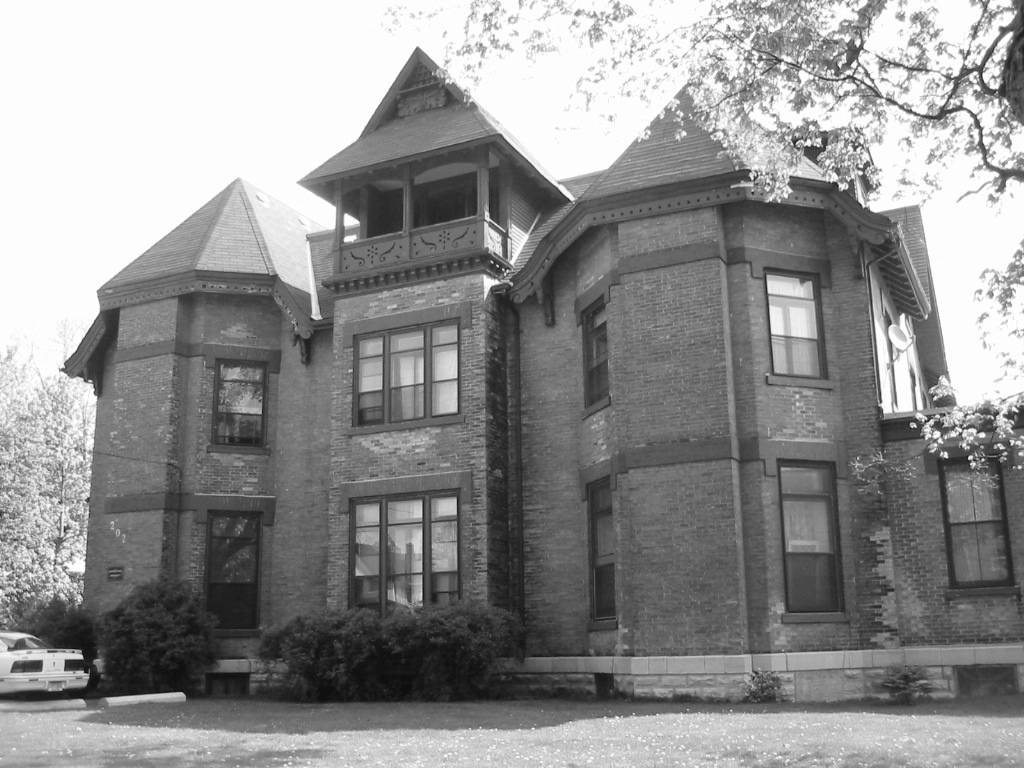
Hatfield Hall private school for girls occupied this building on Green St. until it closed in 1952.
World War II
The outbreak of WW11 again created a number of war -time challenges for St. Peters. In June of 1940 the Rector, Canon Phillip Dykes, announced that he had been appointed chaplain to the 14th Artillery Battery in Petawawa. This led to a succession of priests coming in to take services at the church. Eventually in September 1941, the Rev. Robert Seaborn was inducted as rector but in July of the following year he, too, announced that he had been appointed Chaplain to the Forces, in his case to the Queen’s Own Rifles.
Seaborn had a distinguished career as chaplain. It included being awarded the Croix de Guerre by the French government in recognition of his “heroic ser- vice on D-Day.” Upon his return to the parish in November 1945 he was given a hero’s welcome. Recognition of another hero, Lt. Douglas Denton, killed in April 1945, took the form of a stained glass window on the east wall of the nave and dedicated before a full house including 50 officers and men from his regiment.
Following the war there was a need to revive several aspects of St. Peter’s church life and to tackle a difficult financial situation created by a debt of some $400,000 exclusive of the mortgage. This task fell upon the Rev. Hugh Bedford-Jones who came to St. Peter’s in April 948. By the time he left in 1959 St. Peter’s was once again thriving. Significantly, his son Michael who grew up here, subsequently became one of the bishops of the Toronto diocese. In that capacity he was, for a time, responsible for the Trent-Durham Episcopal area which includes St. Peter’s.
In October 1950 the buildings easily could have been destroyed when fire broke out in the gymnasium in a pile of Boy Scout gear. It took place during a communion service in the church and Hugh Bedford-Jones told the congregation to leave and to carry books and furniture out. Firemen quickly got the blaze under control and damage was confined to the gymnasium.
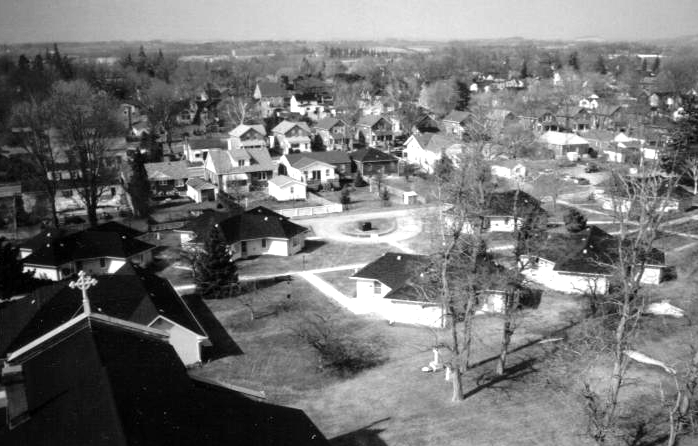
St. Peter’s Court as seen from the church tower. It consists of 64 small bungalows for the elderly built on church land in the 1960s.
Photo: Doug Beauchamp.
An Ambitious Outreach Project
The Rev. Edgar Bull, who was rector in 1963, initiated a task force to study the possibility of using vacant church land behind the rectory for purpose of accommodation for needy seniors. It was estimated there were 655 people in Cobourg over the age of 70 in that year. When Edgar Bull left St. Peter’s in 1965 his main regret was that little progress had been made. However, his successor, the Rev. Duncan Abraham, who arrived later that year, made the project a major priority and with the help of a bequest from the late Lionel Vivian, and a resolution from a general meeting of the parish, the land was transferred to the newly-formed St. Peter’s Court Apartment Corp. for $1.00. The agreement called for the land to revert to the Corporation of St. Peter’s when the mortgage was paid off In 1967, 32 small bungalows were built for the elderly as well as for people on very limited income and people suffering from disabilities. It was called St. Peter’s Court, and was followed by a further 32 bungalows in 1969. The mortgage on the first batch of houses will be paid off in 2017, and on the second batch in 2019.
In July 1966 St. Peter’s parishioners, and many others in Cobourg, were deeply saddened when Miss Kathleen Warner, the former organist, was killed by a car right outside the church on her way to play for Even- song. She had been a capable and much-loved organist and choir director for St. Peter’s for no less than 50 years. She had recently retired, though had continued to play as substitute organist.
In 1967, Canada’s Centennial Year, the Diocese of Toronto had asked all its churches to consider under- taking projects of a personal nature in their own area, across Canada and around the world. St. Peter’s chose to support a summer ministry at the campsite in Presque’ile Provincial park, the parish of Hastings, two aboriginal support projects in Canada’s North, and a mission ministry in India. In 1969 St. Peter’s celebrated the 150th anniversary of the founding of the parish. A special service of Thanksgiving and Re dedication was held with the Lieutenant Governor of Ontario, William Earl Rowe, present.
Each November for many years St. Peter’s has held a Remembrance Sunday service which draws a large congregation including members of the Royal Canadian Legion and their families. Also present are members of the Royal Marines Association of Canada for which St. Peter’s is the garrison church. Music is sup- plied by the Cobourg Concert Band and the service is followed by a march-past with the salute taken by the Rector and a senior member of the military or the Legion. In 1976 twelve holders of the Victoria Cross and the George Cross were present.
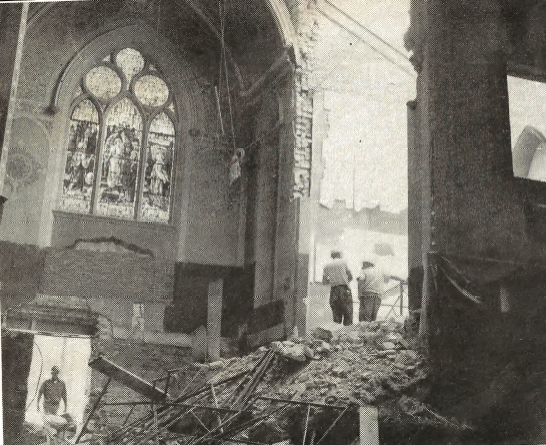
The scene of desolation as excavation took place around the foundations. A hole was cut in the chancel east wall to enable bulldozers to enter the building.
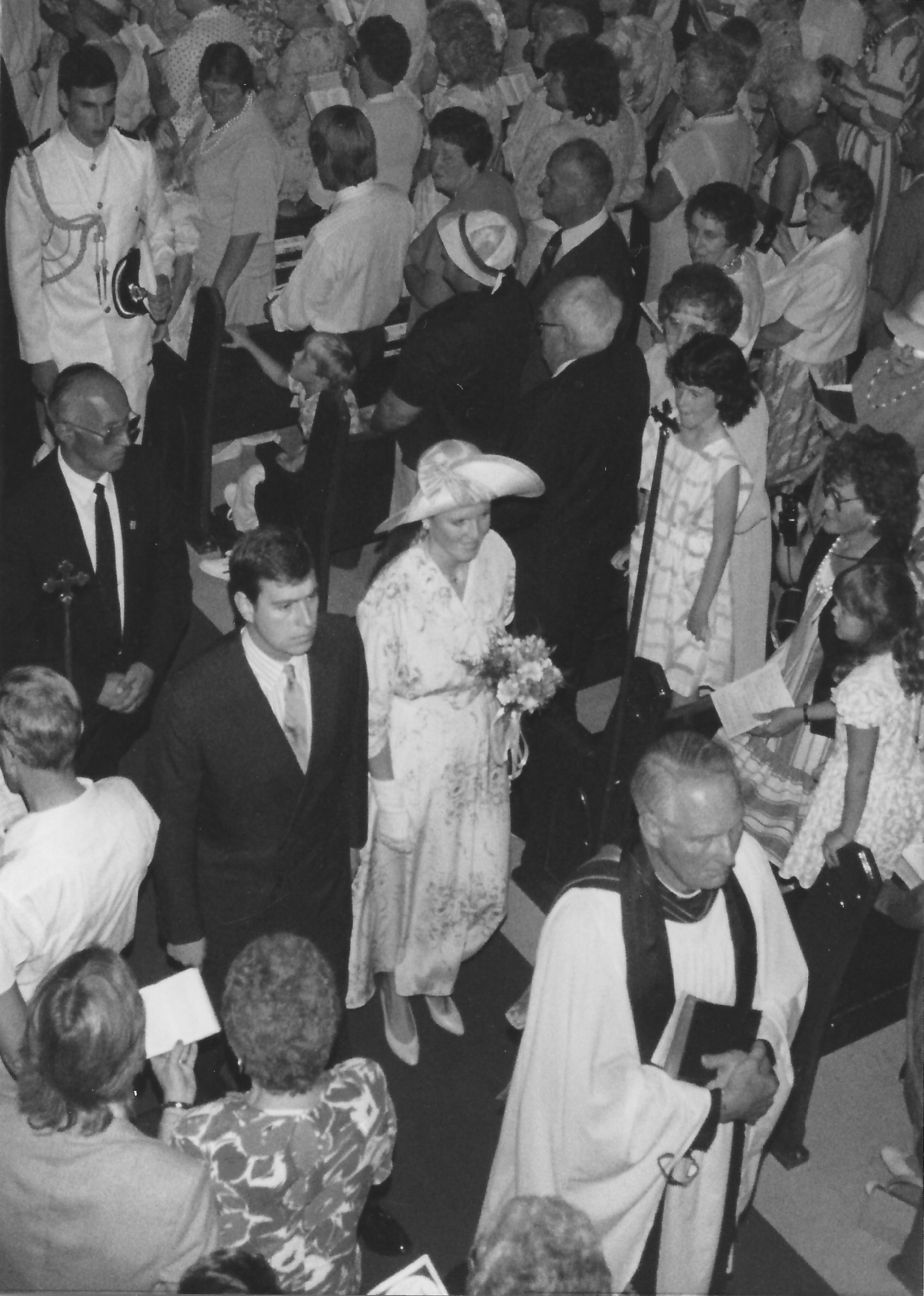
In July 1987, The Queen’s son Prince Andrew and the Duchess of York attended a service at St. Peter’s on the occasion of Cobourg’s 150th anniversary.
Avoiding abandoning the building
In 1977 St. Peter’s was faced with a very serious dilemma brought about by deterioration of the main church building. The foundations had crumbled to the extent that the walls had moved some 3 inches. With- out drastic action the building would have had to be abandoned. The solution would involve the floor of the church being removed, and the area under it excavated to allow the foundations to be re-constructed and basement rooms added. For nine months the church was a scene of desolation. A large part of the east wall of the chancel had to be removed to allow earth- moving equipment into and out of the building. During this time services were held in the upper room of the Parish Hall.
The renovation program was undertaken at a cost of $365,000. Under the energetic leadership of the rec- tor, the Rev. Terry Tarleton, a former insurance executive, this large sum was completely paid off by October 1982. In part, this was made possible by a very generous legacy from two tireless workers for St. Peter’s, John and Ethel Hutton. Only seven years later
several improvements and extensions to the other parts of the building were undertaken. They included a mezzanine area of meeting rooms above the gymnasium and an extension to contain a new rector’s office, all at a cost of $800,000.
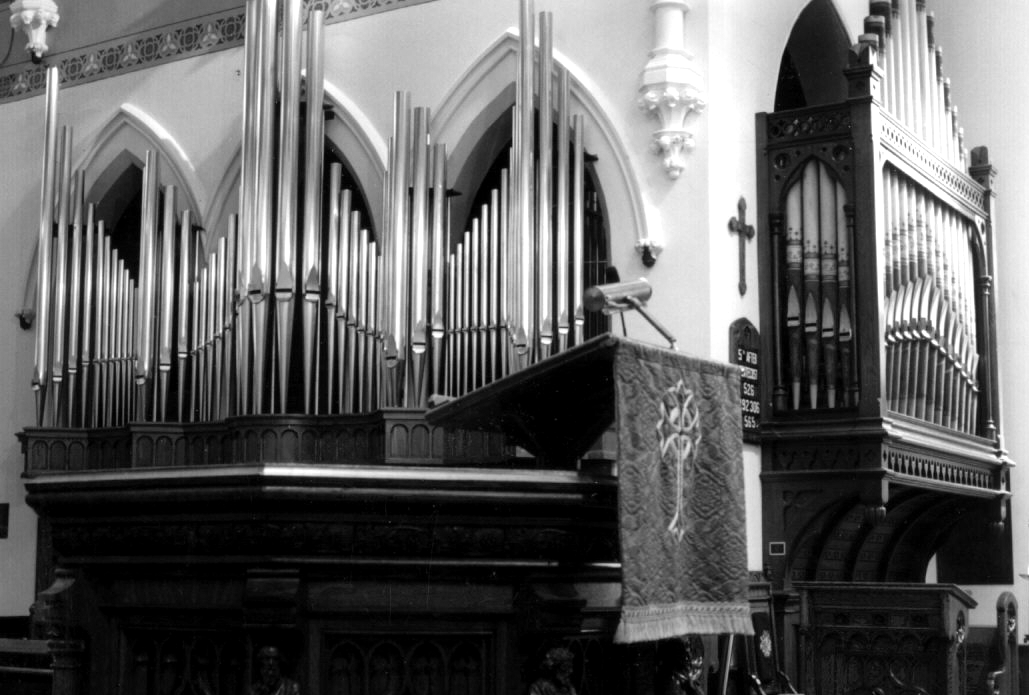
Organ pipes after renovation in 1998 as a tribute to former rector Terry Tarleton and his wife Mary.
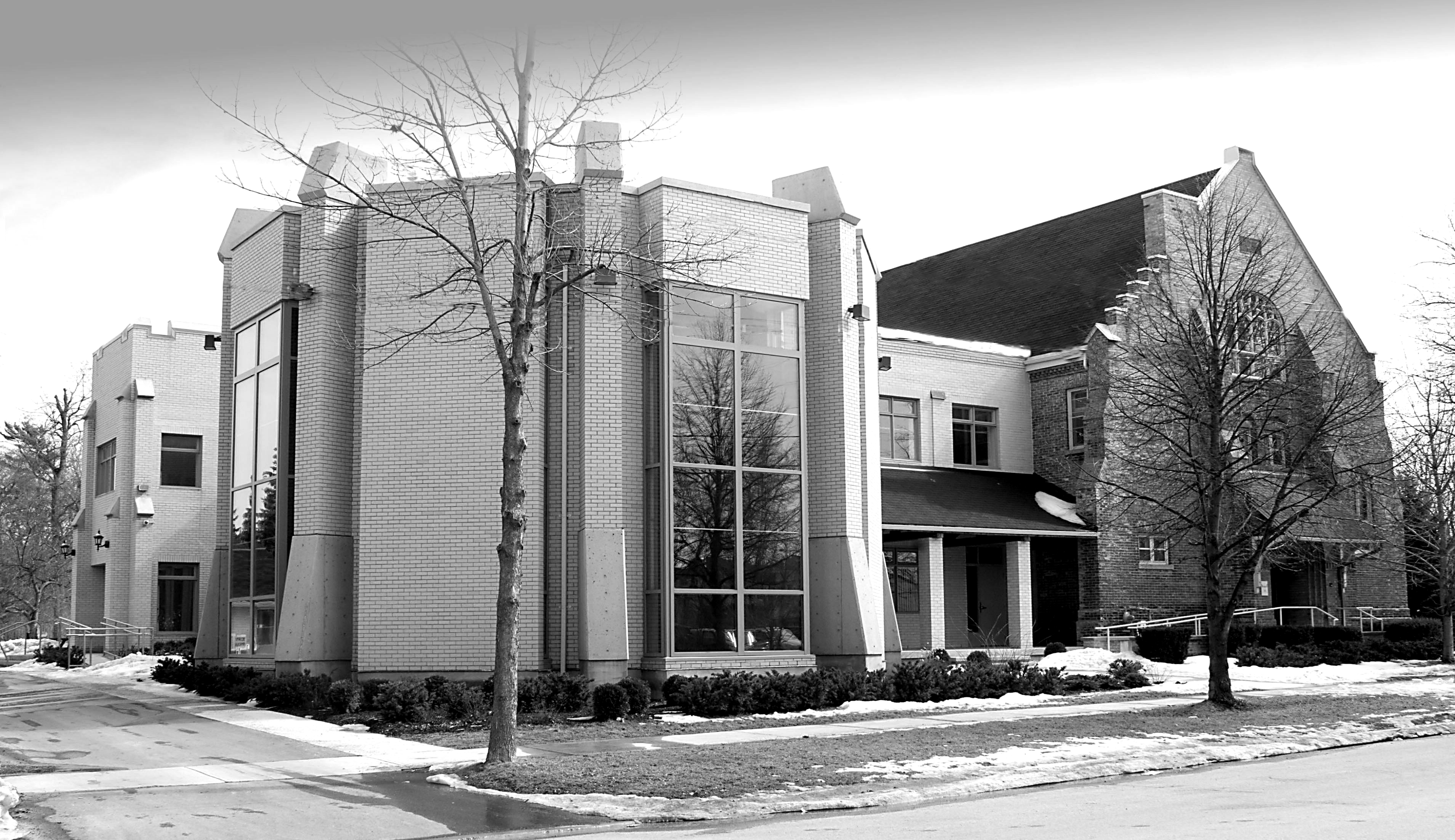
The hexagonal St. Paul’s multi-use Chapel, seating 100 people, was one part of a major Millennium project.
A Strong Musical Tradition
Music has always played a major role in church services at St. Peter’s. The original pipe organ built by S.R. Warren & Co. of Montreal in 1873 had undergone several modifications over the years. However, in 1998, a major restoration was required. This involved enlargement of an opening through the north-east wall of the nave. A new façade, with inactive but decorative pipes obtained from the former St. Cyprian’s church in Toronto and set in an elegant wood screen was built in front of active pipes. Upon completion of the project in 1999, the enlarged three-manual organ was thought to be one of the finest between Montreal and Toronto.
St. Peter’s music programs have, over the years, produced acclaimed choirs of adults and young people including, since the mid 1990s, hand-bell choirs as well. Helpful training for young choristers of the church is provided by annual musical scholarships derived from a bequest in honour of a former choir member.
A Big Millennium Project
Growth of ministries in the 1990s during the early incumbency of Canon Peter Walker had imposed severe limitations on St. Peter’s meeting the needs of a 21st Century church. Also, through Associate priest, Rev. Dr. Ron Kydd, St. Peter’s had become the Cobourg campus for lay courses offered by Wycliffe Theological College of the University of Toronto. A ‘Millennium Task Force’ commissioned in 2000 under the late Hon. Allan Lawrence, made a systematic analysis of future needs, to identify changes to the building needed to accommodate them, and to propose a comprehensive plan for raising the capital funds necessary to complete the project.
Eventually, plans calling for major additions and re- configuration of previous buildings on the West and North of the church sanctuary were adopted to a total cost of $3,700,000 of which members of St. Peter’s would contribute about one third. Very large bequests from two former parishioners, together with grants from the Diocese of Toronto and a gift from Paul Helliwell, a philanthropist interested in Christian Education, would fund the remainder. Helliwell, whose gift enabled the addition of rooms in an Educational Centre, died before completion of the project.
Construction work did not go smoothly. One of several problems was that it was required to come to an abrupt halt when pieces of human remains were unearthed well below the normal burial depth. As new graves surrounded the original church building until the 1850s it is assumed the remains had been repositioned in the course of earlier construction. It nevertheless prompted a good deal of speculation as to their origin and caused delay and considerable additional costs to the project. A special service of re-interment of the bones was subsequently held at St. Peter’s Heritage Cemetery.
The Millennium project was finally completed in 2005 though at greatly added costs due, in part, to difficulty of re-engaging contractors at a time of greater employment than at the earlier time. It provided architecturally blended and practical facilities for worship, out- reach, pastoral care, and learning. The facilities are also used by a wide range of community groups. . An- other is a Resource Centre containing the most comprehensive collections of contemporary Christian literature and other resources in the Cobourg area.
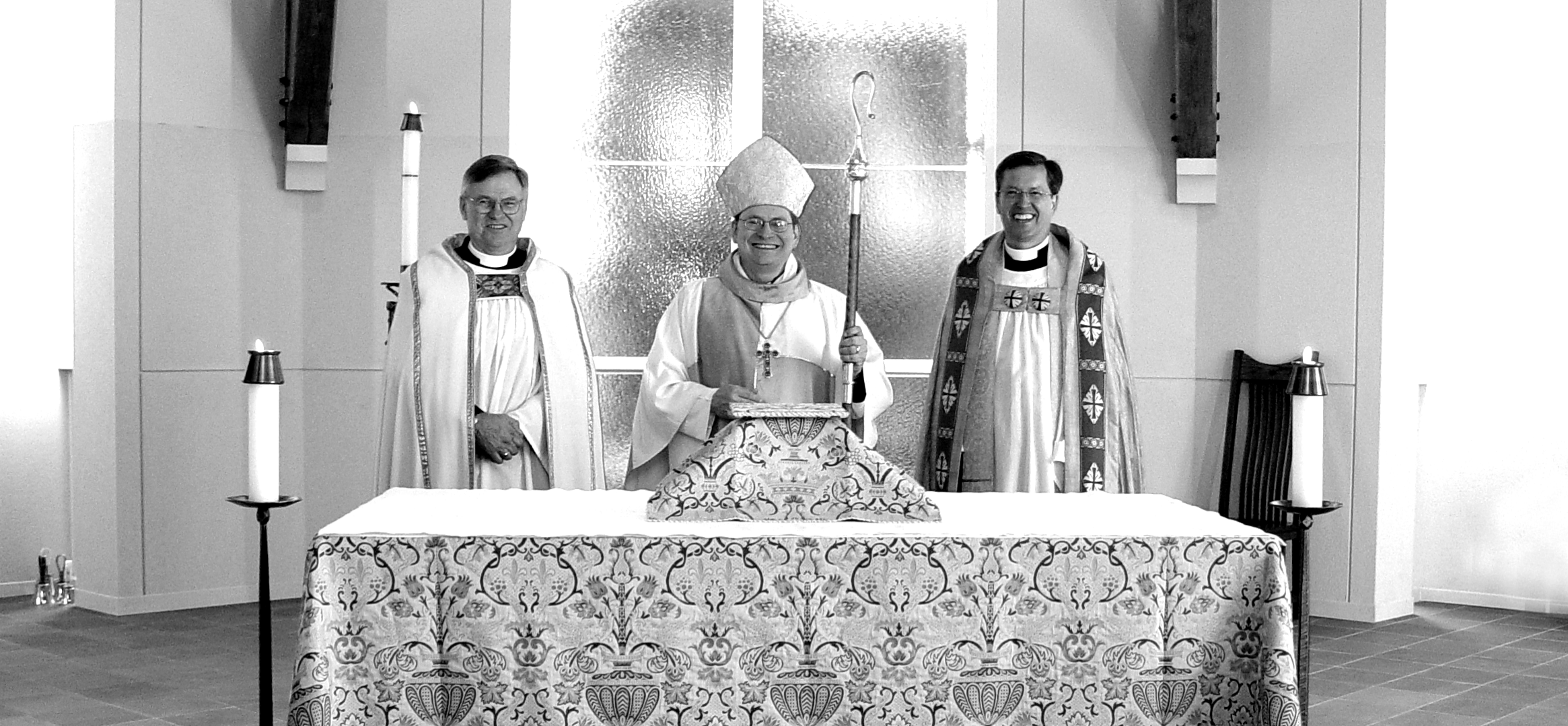
The Millennium Project concluded in September 2005 with the dedication of the new St. Paul’s chapel by Bishop Colin Johnson with (left) Rev. Dr. Ron Kydd (associate priest) and Canon Peter Walker (rector)
. Marianne Anderson photo
Outreach Projects
The famous quotation by the late Archbishop of Canterbury, William Temple: “The Church is the only society that exists for the benefit of those who are not its members” is taken very seriously. Outreach programs of a local, national and international nature have long been an important feature of St. Peter’s church life.
One major international initiative is the Mzuzu project. In the 1990s the Town of Cobourg was ‘twinned’ with the City of Mzuzu in Malawi, Central Africa — one of the world’s poorest regions and beset by starvation and AIDS on a huge scale. Under the late Angus Read, a St. Peter’s member and former mayor, the church be- came ‘twinned’ with St. Mark’s Anglican church in Mzuzu. In 2005, St. Mark’s was attempting to feed 250 AIDS orphans but could not manage the cost. St. Peter’s response was a Mzuzu AIDS Orphans’ Feeding Program to provide regular meals for the orphans. St. Peter’s with help from other people in Cobourg and nearby, have since added programs for the orphans in health care, education and some skills.
In Canada St. Peter’s outreach programs include assistance to a northern native community, and regional projects of the Toronto Anglican Diocese through its Faithworks initiatives.
St. Peters played a leadership role in the formation of NeighbourLink in 1993 and ever since. This is a multi- denominational organization which, in addition to many assistance programs and activities for people in need, runs three soup kitchens weekly at the church for much of the year. Another outreach program includes the St. Peter’s Crisis Fund, also to help people in need.
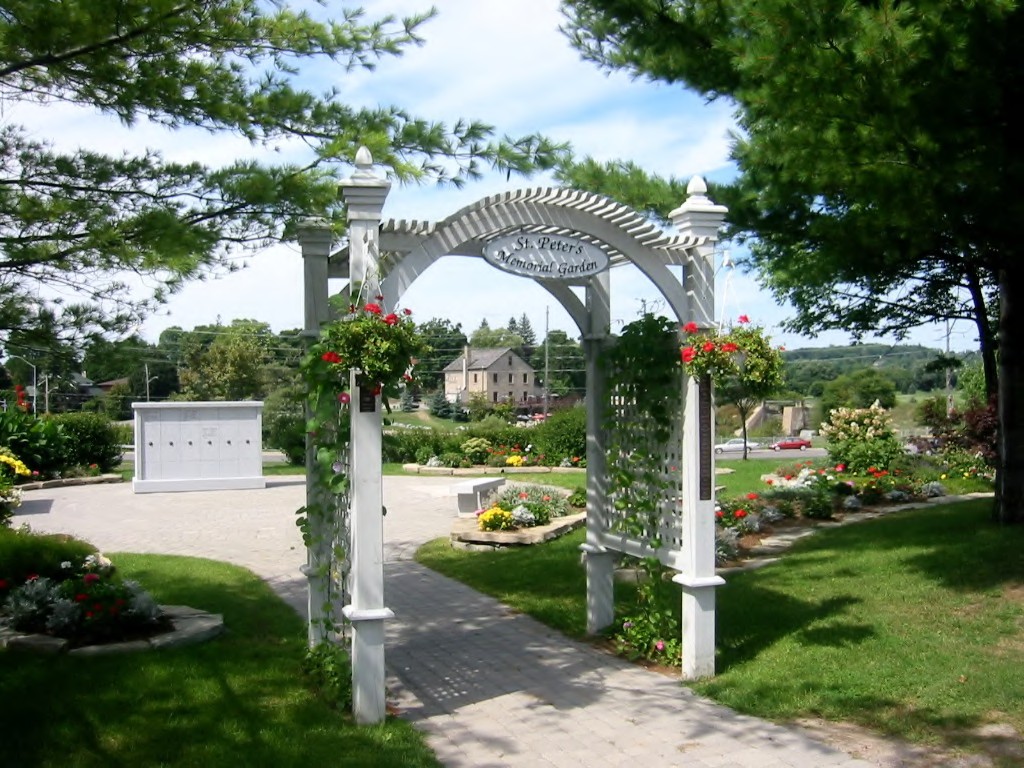
In the 1850s a cemetery site at Pratt’s Mill (centre), at Ontario and Elgin Sts., that is now St. Peter’s Heritage Cemetery was acquired by St. Peter’s. Shown is the entrance to the memorial garden in 2005. Two more Columbia for ashes have since been added.
Parish Nurse
Health and healing have been promoted by Christian- ity since its inception and St. Peter’s has had an active Health and Healing ministry for the past 18 years. During this time activities have included an ongoing health education program involving lectures and discussions, and holding regular blood pressure clinics. Highly sig- nificant is a parish nurse as a part- time staff member. Three parish nurses, all recently retired from full-time nursing, have been engaged since the inception of the program. Each has demonstrated a strong sense of Christian mission and, together with their professional experience, has proven invaluable in providing advice and comfort to members facing health issues.
The Changing Role of Women
Over the years a major trend at St. Peter’s, as with most Anglican churches, has been a changing role for women in the life of the church. In the early days, while always busy in various aspects of church work, they were absent from any major decision-making roles. Today, on the other hand, many of the priests and some bishops are female. In fact, both the current bishop of the area that encompasses St. Peter’s and the Priest in Charge of St. Peter’s are women. Also, many church management roles have recently been under- taken by female church-wardens. Ironically, at the same time, Anglican Church Women, an organization involving all the women of the church in a great many activities of behalf of the parish for many years, has been greatly diminished by a reduction in active members. This is due to increasingly high levels of full- time female employment.
Communications
Church communications at St. Peter’s has seen great changes resulting from new technologies. Computer- generated methods now help to keep irregular church goers up-to-date. One traditional feature of parish communications since the mid-1980s is the magazine Keynotes published five times a year. Initially a simple newsletter, it has grown into a 32-page magazine.
St. Peter’s Pre-school
Church communications at St. Peter’s has seen great changes resulting from new technologies. Computer- generated methods now help to keep irregular church goers up-to-date. One traditional feature of parish communications since the mid-1980s is the magazine Keynotes published five times a year. Initially a simple newsletter, it has grown into a 32-page magazine.
One Millennium Project was to establish a pre-school at St, Peter’s with a Christian focus. This finally took place in 2005 The school offers a curriculum based on weekly themes such as the arts, literacy and numeric skills, and physical activity.
The school provides an introduction to the Christian faith with emphasis on the moral and character development of young children. It operates on weekdays from September through June.
Additional Historical Information
The following references are available for viewing or on loan in the Resource Centre at St. Peter’s church.
St. Peter’s Church from the Beginning” by Francis Dowe. The 84-page book covers the history of the church from 1819 to 1867
“The Church of St. Peter” by Arthur Broadbridge. A 240-page book on the history from 1867 to 1978
“Upon this Rock” A 12 minute DVD covering St. Peter’s architectural history.
Cobourg Star newspaper supplement on the occasion of St. Peter’s 175th anniversary, June 1994
“Cobourg’s Churches over the Life of the Town” A 62- page summary by Jim Weller on the history of 14 Co- bourg churches at Cobourg’s 175th anniversary in 2012.
Parish magazine ‘Keynotes’ Copies dating from 1986 to the present time.
